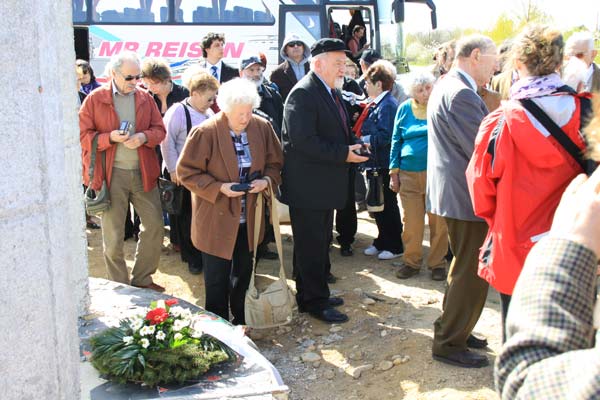‘The past is another country’, wrote the British historian Tony Judt in order to describe how the European society used to deal with the Nazi regime after 1945. This distant land of the past, however, can be right in front of your door today. This is what the people of Strasshof, a small town near the Austrian capital Vienna, had to face when they started looking for the traces of a forced labour camp located here during World War II.
The actual history of the camp began in 1942. Unlike previous expectations the Nazi leaders had to realize in the autumn of 1942 that victory over the Russian Red Army could not be achieved before winter. And there was a crucial shortage of manpower for domestic deployment, which had to be replaced. This is why the programme of deploying forced labourers on a large scale got started. For this purpose, initially 22 transit camps were erected within the territory of the German Reich, Strasshof being one of them. This site was chosen because it was near Vienna, and with the ‘Nordbahn’, the main railway leading from Vienna to Eastern Europe, it offered excellent transport facilities. The barracks built there provided accommodation for 6000 people, who were detained there for a short period of time before being transferred to their workplaces in eastern Austria.

People from all over Europe were taken to Strasshof by force. Transport convoys from Ukraine, Russia, Serbia, Greece, France, Belgium, Hungary, Poland etc. ended up at the camp. After arriving, the deportees had to undergo disinfection, and their clothes were taken away and cleaned of pests with poisonous gas. The naked internees were taken to the lavatories for showering in small groups. Then they were examined by doctors as to their employability. When this was certified, official employment agents entered the personal data of each individual in a register. The recruiting procedure was completed with taking fingerprints and a photo for the ‘Fremdarbeiterausweis’, the official foreign worker ID. Thereafter camp guards took the internees to the so-called ‘clean’ part of the camp. Provided with just a little soup and dehydrated vegetables, they usually stayed there for a few days before the labour exchange assigned them to a particular company and organized their transfer.
The Strasshof transit camp also contained a sick camp, where the diseased forced labourers of the region were treated. Due to constant physical overexhaustion, the general state of health was extremely bad and resulted in a high rate of mortality. The mass burial site on the Strasshof cemetery bears witness to that.
Apart from the large transit camp, there were several other smaller camps situated in Strasshof. The people kept there were deployed in local agriculture and the construction of the railway premises of the Deutsch Wagram airbase bordering the Strasshof area.
In the summer of 1944 the German Empire had lost some of the territory where they had recruited foreign workers before. As compensation 20.000 Jewish men, women and children were deported to Strasshof from Hungary. Those were lucky to escape being killed in Ausschwitz, but instead, they were deployed in forced labour in eastern Austria.
The attempt to transfer parts of them via Strasshof to the concentration camp in Theresienstadt failed because the railway tracks were destroyed in an allied airstrike in March 1945. The Russian Red Army liberated the transit camp on April 10, 1945. After the end of the war the barracks disappeared rapidly because building material was desperately needed elsewhere. And in the same way, memories of the camp vanished among the local people.
In 2006 the name of Strasshof became known worldwide in connection with the criminal case of Natascha Kampusch. As a consequence, a group of Strasshof people got together in order to confront the gloomy and nasty image of the town as it was spread in the media. And they were determined to take a critical look at its past.

In 2011 the VAS, Verein Arbeitsgruppe Strasshof, had a memorial site erected, designed and constructed by the artist Karl-Heinz Schreiner. It was built with financial support of the Strasshof town council, the provincial government of Lower Austria, the relevant federal government organisation called ‘Nationalfonds’, and private donators.
Situated close to the site of the former camp, this memorial is meant to commemorate the unpleasant past even if its last remnants and traces will have disappeared in the landscape. Furthermore the findings of the research were summarized in a publication edited by the journalist Irene Suchy. In this book contemporary witnesses of the area and surviving Hungarian victims recall their memories and tell about their experiences.
In continuation this kind of work , we, the members of the VAS feel committed to find and collect further material in order to reconstruct and preserve the almost forgotten history of the Strasshof camp, and, above all keep the victims’ memories alive.
Contact:
Bernhard Blank, Chairman of VAS
Holiczerstrasse 20
2231 Strasshof
Austria
bernhard.blank@vas-strasshof.at
